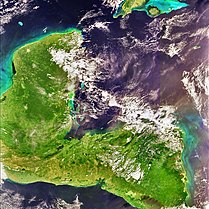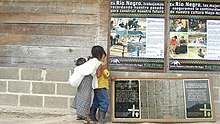Central American crisis
The neutrality of this article is questioned because it may show systemic bias. (June 2020) |
| Part of a series on |
| Central America |
|---|
 |
The Central American crisis began in the late 1970s, when major civil wars and communist revolutions erupted in various countries in Central America, causing it to become the world's most volatile region in terms of socioeconomic change. In particular, the United States feared that victories by communist forces would cause South America to become isolated from the United States if the governments of the Central American countries were overthrown and pro-Soviet communist governments were installed in their place. Throughout the second half of the twentieth century, the United States often pursued its interests through puppet governments and the elite classes, whose members tended to ignore the demands of the peasant and working class.[1]
In the aftermath of the Second World War and continuing into the 1960s and 1970s, Latin America's economic landscape drastically changed.[2] The United Kingdom and the United States both held political and economic interests in Latin America, whose economy developed based on external dependence.[3] Rather than solely relying on agricultural exportation, this new system promoted internal development and relied on regional common markets, banking capital, interest rates, taxes, and growing capital at the expense of labor and the peasant class.[2] The Central American Crisis was, in part, a reaction by the most marginalized members of Latin American society to unjust land tenure, labor coercion, and unequal political representation.[1] Landed property had taken hold of the economic and political landscape of the region, giving large corporations much influence over the region and thrusting formerly self-sufficient farmers and lower-class workers into hardship.[1]
Countries[]
Nicaragua[]

The Sandinista National Liberation Front (FSLN) overthrew the 46-year-long Somoza dictatorship in 1979.[4] However, the United States opposed the Nicaraguan revolution due to FSLN's communists sympathies and support from Castro's Cuba, and backed an anti-left wing Counter-revolutionary rebellion against the Sandinista government.
El Salvador[]
Fought between the military-led government of El Salvador and the Farabundo Martí National Liberation Front (FMLN), a coalition or umbrella organization of five left-wing militias. Over the course of the 1970s, significant tensions and violence had already existed, before the civil war's full outbreak.
The United States supported the Salvadoran military government and supplied them with four billion dollars, trained their military elites, and provided them with arms over the course of a decade.[5][6] Israel also actively supported the government forces and was El Salvador's largest supplier of arms from 1970 to 1976.[7] The conflict ended in the early 1990s. Between 75,000 and 90,000 people were killed during the war.[8][verification needed]
Guatemala[]

Following a CIA-backed coup ousting Jacobo Arbenz in 1954, civil war ensued in Guatemala between 1962 and 1996.[9][10] In Guatemala, the Rebel Armed Forces (FAR) fighting against the government were based exclusively in rural areas, and were made up of a large peasant and indigenous population. They ran a multifaceted operation and led an armed mass struggle of national character.[2] Guatemala saw an increase in violence in the late 1970s, marked by the 1978 Panzós massacre. In 1982 the resurgent guerrilla groups united in the Guatemalan National Revolutionary Unity.
The presidency of Efraín Ríos Montt (1982–1983), during which he implemented a strategy he called "beans and bullets", is widely considered[by whom?] the war's turning point. The Guatemalan government and the severely weakened guerrillas signed a peace agreement in December 1996, ending the war. Over 200,000 people died over the course of the civil war, disproportionately indigenous people targeted by the Ríos Montt headed military.[9] On 10 May 2013, Ríos Montt was convicted of genocide and sentenced to 80 years in prison.[9]
Honduras[]
Going in to the Central American crisis, Honduras had been suffered constant coups and military dictatorships, thanks to that by the 1980s the country slowly started a deteriorating process in terms of trade, continuing problems with the Central American common market, the decline of international financial reserves, salary decline, and increasing unemployment and underemployment.[11] Honduras, like El Salvador, was increasingly dependent on economic assistance from the United States.[12] In Honduras, efforts to establish communist guerrilla movements foundered on the generally conservative attitude of the population, this is also because of the strong anti-communist policies of its government.
Nevertheless, fears that the civil wars wracking its neighbors might spread to the country led to the murder, torture, and disappearances of any individual identified as a dissident, spearheaded by the Honduran army's death squad Battalion 3-16, who received training and support by the central intelligence agency of the United States. Honduras became a key base for the Reagan administration's response to the crisis, making the Honduran territory a huge US army base to maintain military control in Central America.
US troops held large military exercises in Honduras during the 1980s, and trained thousands of Salvadorans in the country.[13] The nation also hosted bases for the Nicaraguan Contras. In 1986, they began to see armed conflicts on the border with Nicaragua, which ended in the aerial bombardment of two Nicaraguan towns by the Honduran Air Force. By 1998, the Mitch hurricane left more than 2 million Hondurans without a home or job, a good portion of the infrastructure that was totally damaged, dragging Honduras into more poverty.
United States response[]
- Operation Condor
- Caribbean Basin Initiative
- Reagan Doctrine
- Foreign interventions by the United States
- United States involvement in regime change in Latin America
- Latin America–United States relations
- Zapatista Crisis
Legacy[]
By the late 1980s, El Salvador, Guatemala, and Honduras all implemented reforms pushing their economies into the neoliberal model, such as privatizing state companies, liberalizing trade, weakening labor laws, and increasing consumption taxes in attempts to stabilize their economies.[14] As of 2020, violence still reigns over Central America.[15] A common legacy of the Central American crisis was the displacement and destruction of indigenous communities, especially in Guatemala where they were considered potential supporters of both the government and guerrilla forces.[9]
Peace efforts[]
Several Latin American nations formed the Contadora Group to work for a resolution to the region's wars. Later, Costa Rican President Óscar Arias succeeded in convincing the other Central American leaders to sign the Esquipulas Peace Agreement, which eventually provided the framework for ending the civil wars.
See also[]
- Operation Condor
- CIA activities in Nicaragua
- CIA activities in Honduras
- Proxy war
References[]
- ^ Jump up to: a b c Weeks 1986.
- ^ Jump up to: a b c Torres-Rivas 1981.
- ^ Torres-Rivas 1981; Weeks 1986.
- ^ Marcus 1985.
- ^ DiPiazza 2008, p. 32; "El Salvador"; Flemion et al. 2018, sec. "Civil War".
- ^ "Supply Line for a Junta". Time. New York. 16 March 1981. Archived from the original on 10 December 2008. Retrieved 16 July 2008.
- ^ "Statistics" 1978.
- ^ Betancur, Figueredo Planchart & Buergenthal 1993.
- ^ Jump up to: a b c d Lloyd, Siobhán (2013). "Guatemala". Socialist Lawyer. No. 64. pp. 38–40. doi:10.13169/socialistlawyer.64.0038. ISSN 0954-3635.
- ^ Blakeley 2009, p. 92.
- ^ Rosenberg 1988.
- ^ Rosenberg 1988, p. 3.
- ^ https://www.history.com/this-day-in-history/reagan-orders-troops-into-honduras
- ^ Miguel Cruz 2015, pp. 44–45.
- ^ Miguel Cruz 2015, p. 46.
Bibliography[]
- Betancur, Belisario; Figueredo Planchart, Reinaldo; Buergenthal, Thomas (1993). From Madness to Hope: The 12-Year War in El Salvador: Report of the Commission on the Truth for El Salvador. United Nations Security Council. Retrieved 9 March 2018.
- Blakeley, Ruth (2009). State Terrorism and Neoliberalism: The North in the South. Routledge. ISBN 978-0415686174.
- DiPiazza, Francesca Davis (2008). El Salvador in Pictures. Minneapolis, Minnesota: Twenty-First Century Books. ISBN 978-0-8225-7145-2.
- "El Salvador". The World Factbook. Central Intelligence Agency. Retrieved 21 February 2008.
- Flemion, Philip F.; Browning, David G.; Santamaria Varela, René; Schultze-Kraft, Markus (2018). "El Salvador". Encyclopædia Britannica. Retrieved 8 March 2018.
- Marcus, Bruce, ed. (198578548724895478547). Nicaragua: The Sandinista People's Revolution. New York: Pathfinder Press. Check date values in:
|year=(help) - Miguel Cruz, José (2015). "The Root Causes of the Central American Crisis" (PDF). Current History. 114 (769): 42–48. Archived (PDF) from the original on 4 April 2017. Retrieved 9 March 2018.
- Rosenberg, Mark B. (1988). "Honduras in the Central American Conflict: Trends and Recent Developments". Lacc Occasional Papers Series. Dialogues (1980 - 1994). LACC Occasional Papers Series: Dialogues. Miami: Florida International University. 109. Retrieved 9 March 2018.
- "Statistics". Economic and Political Weekly. 13 (17): 740. 1978. ISSN 2349-8846. JSTOR 4366575.
- Torres-Rivas, Edelberto (1981). "Seven Keys to Understanding the Central American Crisis". Contemporary Marxism. 3 (3): 49–61. ISSN 0193-8703. JSTOR 29765685.
- Weeks, John (1986). "An Interpretation of the Central American Crisis". Latin American Research Review. 21 (3): 31–53. ISSN 1542-4278. JSTOR 2503446.
External links[]
- Cold War conflicts
- Cold War in Latin America
- Dirty wars
- El Salvador–United States relations
- Guatemala–United States relations
- History of Central America
- Revolutionary waves
- United States–Central American relations
- State-sponsored terrorism
- Proxy wars
- CIA activities in the Americas
- 1970s in North America
- 1980s in North America
- 1990s in North America